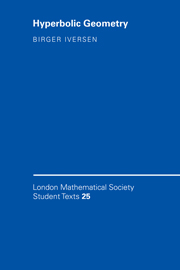Summary
What is hyperbolic geometry? Let me try to give an answer by telling the story of the parallel axiom. I shall use modern language which will ruin part of the story but highlight the basic points.
Axioms for plane geometry A simple set of axioms for plane geometry can be presented in the framework of metric spaces. By a line in a metric space X we understand the image of a distance preserving map γ:ℝ→X. The three axioms of plane geometry are (the axioms are analysed in an appendix)
INCIDENCE AXIOM Through two distinct points of X there passes a unique line. The space X has at least one point.
REFLECTION AXIOM The complement of a given line in X has two connected components. There exists an isometry σa of X which fixes the points of the line, but interchanges the two connected components of its complement.
PARALLEL AXIOM Through a given point outside a given line there passes a unique line which does not intersect the given line.
Investigations of the parallel axiom by among others J.Bolyai (1802 – 1860), C.F.Gauss (1777–1855), N.I.Lobachevsky (1793–1856) show that this axiom is independent of the other axioms in the sense that there exists a plane, the so called hyperbolic planeH2, which satisfies the first two axioms of plane geometry but not the parallel axiom. H2 is unique in the following sense.
CLASSIFICATION THEOREM A metric space which satisfies the three axioms of plane geometry is isometric to the Euclidean plane.
- Type
- Chapter
- Information
- Hyperbolic Geometry , pp. ix - xivPublisher: Cambridge University PressPrint publication year: 1992



